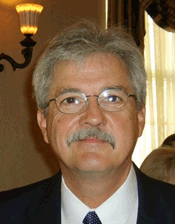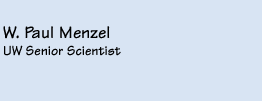Vita
Education
| Ph.D. |
|
1974 |
|
University of Wisconsin - Madison |
| |
(Theoretical Solid State Physics)
|
| M.S. |
1968 |
University of Wisconsin - Madison
|
| B.S. |
1967 |
University of Maryland - College Park |
| |
(with high honors, Omicron Delta Kappa, Phi Beta Kappa) |
Experience
| |
|
|
 |
|
2007 - present
UW Senior Scientist
Currently at the University of Wisconsin, I am pursuing research interests and
teaching classes in remote sensing of atmospheric temperature and moisture profiles,
ozone, carbon dioxide, cloud properties, and surface properties. The current focus
of my research is inferring cloud property trends over the past three decades. In the
classroom I am using my textbook titled "Remote Sensing Applications with Meteorological
Satellites" that has been published as a World Meteorological Organization technical document. |
| |
|
|
 |
|
1999 - 2007
Chief Scientist for the Center for Satellite Applications and Research
As the Chief Scientist for the Center for Satellite Applications and Research (formerly known as the Office of Research and Applications) in NOAA/NESDIS, I was responsible for providing guidance on science issues and initiating major science programs for the Director of the Office. |
| |
|
|
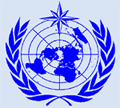 |
|
1999 - 2006
International Expert Team Chairman
As the chairman of the World Meteorological Organization Expert Team on Observational Data Requirements and Redesign of the Global Observing System, GOS (that reports to the Commission for Basic Systems Open Program Area Group on Integrated Observing Systems) I lead 12 international experts in (a) reviewing observing system experiments indicating the relative contribution from various components of space based and ground based observing systems, (b) recommending steps for the evolution of the surface and space-based components of the GOS and (c) reporting to the CBS on how well the GOS is meeting user requirements in various applications areas and how the GOS performance can be improved. |
| |
|
|
 |
|
1989 - present
Principal Investigator
As a member of the MODIS (Moderate resolution Imaging Spectrometer) science team, I am responsible for developing algorithms for the cloud mask, cloud properties, and atmospheric profiles. Early work included design, test, and application of the MODIS Airborne Simulator, a passive infrared radiometer flown on ER2 aircraft used to study cloud radiative properties (emissivity, height, temperature, phase) at 50 meter resolution. After launch of the EOS Terra and Aqua Platforms, the MAS experience was transferred to processing the MODIS 1 km resolution data routinely and studying the global cloud and moisture trends. To date the cloud top properties algorithm has been adjusted to account for calibration changes and cloud validation with CALIPSO. A continuous record of MODIS and HIRS (High resolution Infrared Sounder) cloud properties from 1978 onward is being established. |
| |
|
|
 |
|
1997 - 2000
Science Director of Cooperative Institute
As the Science Director of the Cooperative Institute for Meteorological Satellite Studies, I was responsible for the day to day scientific direction of the activities of the CIMSS personnel. This involved coordinating university research principal investigator proposals in response to government funding opportunities, assuring science progress on grants and contracts, fostering peer review publications, and evaluating individual performance. At that time, CIMSS housed about 70 personnel and required about $4 to 5M annual budget. |
| |
|
|
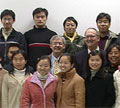 |
|
1986 - present
Adjunct Professor
I teach graduate level courses in satellite remote sensing of the earth-atmosphere system covering atmospheric processes (emphasizing radiative transfer) and satellite applications. A textbook "Applications with Meteorological Satellites" has been published (WMO publication) and distributed internationally. As an adjunct at City College New York, New York and Curtin Univesity of Technology in Perth, Australia and an affiliate of the Atmospheric and Oceanic Sciences Department at at the University of Wisconsin-Madison, I have been advisor to over fifty Masters and PhD students. I have also taught undergraduate physics to science and non-science majors covering Calculus, Mechanics, Electricity and Magnetism, Quantum Mechanics, Atomic Physics, Solid State Physics, Thermodynamics, and Relativity. |
| |
|
|
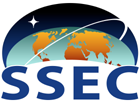 |
|
1967 - present
Scientist
I have participated in the design and test of spacecraft instrumentation for monitoring the earth-atmosphere system. Calibration of infrared sensors has been one of m specialties. I have been co-investigator on about thirty research proposals and author of many of these. Recent activities have centered on developing techniques for retrieving information regarding the three-dimensional temperature and moisture structure from infrared remote sensing. Investigations of cloud properties and associated rainfall have also been part of this work. Research has involved numerical solution of differential equations, development of approximation algorithms with appropriate numerical stability criteria, analysis of special functions and integrals, numerical integration and differentiation, and matrix algebra. Considerable experience with computers has been acquired. |
| |
|
|
Research Fields
Satellite Meteorology
Possibilities for remote sensing of the atmosphere from a geosynchronous and polar orbiting spacecraft are being explored. Specifications for vertical temperature and moisture sounders are being established. Techniques are being developed to exploit the new opportunities offered by GOES-8/9/10 to describe the time variations in the structure and behavior of the atmosphere on the synoptic and mesoscale (e.g., hurricanes and tornadoes). Improved determination of cloud properties (height and emissivity) from indirect infrared sensing over decades initially with HIRS on POES and recently with MODIS and AIRS on Terra and Aqua is another research project.
Theoretical Solid State Physics
This work probed the electronic energy band structure of crystals. The method of linear combinations of atomic orbitals was applied to perfect crystals for Hartree-Fock self-consistent-field calculations of band structures and associated properties such as electronic wave functions of atoms in crystals, electron charge distributions in crystals under various potentials, and transition probabilities of electron excitations. A first principles calculation of the optical properties of crytals (density of states, imaginary part of the dielectric function) was completed. Electronic energy levels and wave functions of complex atom clusters were also determined. Post doctoral work was focused on the electronic states of point defects in crystals (e.g., deep defect levels in semiconductors).
Participation in Select Committees
GOES-R Independent Review Team
– since 2007
Meteosat Sounding Mission Team
– since 1999
WMO Expert Team on Observational Data Requirements and Redesign of the Global Observing System
– since 1999 (chairman)
Upper Air Measurements Project (reporting to Strategic Implementation Team of CEOS)
- since 1997 (co-chairman)
Coordinating Group for Meteorological Satellites
- since 1994
GOES Technical Advisory Committee
- since 1992 (co-chairman)
NESDIS Winds Product Oversight Panel
- since 1989 (chairman for three years)
Earth Observing System (EOS) Moderate-Resolution Imaging Spectrometer (MODIS) Science Team
- investigating cloud properties since 1991
International TOVS Working Group (a committee in the International Radiation Commission)
- since 1983 (co-chair for five years)
Council of the NOAA/NASA Cooperative Institute for Meteorological Satellite Studies (CIMSS) at the University of Wisconsin
- since 1984
Honors
Special Award from EUMETSAT in 2007 - in recognition of unremitting contributions to satellite remote sensing and exemplary leadership in the cooperation between the world's meteorological satellite operators
Distinguished Alumni Fellow Award from the Department of Physics at UW-Madison in 2007 – for achievements in atmospheric physics
American Meteorological Society Fellow in 2007 – In recognition of outstanding contributions to the atmospheric sciences
Department of Commerce Silver Medal in 2007 - for using geostationary measurements to estimate hourly sea surface temperatures that have expanded understanding of ecosystmes, weather, and climate
Department of Commerce Bronze Medal in 2001 – For scientific leadership, both nationally and internationally, in the area of operational space-based remote sensing
Department of Commerce Bronze Medal in 1999 – For the development and implementation of distance learning technology to enhance the expertise of NWS forecasters
ARAD Trainer of the Year in 1997 - for efforts and achievements to provide training in atmospheric physics and atmospheric sounding from satellites to field forecasters
Special Award from the American Meterological Society in 1997 - for extraordinary leadership efforts in introducing information from the new GOES series to weather forecasters throughout the Western Hemisphere
Department of Commerce Silver Medal in 1994 - for science support for the newest geostationary weather satellite, GOES-8
Department of Commerce Silver Medal in 1993 - for collaboration with European scientists on improved Meteosat calibration and wind measurement
Transactions Prize Paper Award from the Geoscience and Remote Sensing Society in 1992 - awarded for IEEE paper on MODIS
Haydn Williams Fellow at Curtin University, Perth, Australia in 1990 - conducted research and taught for one semester
